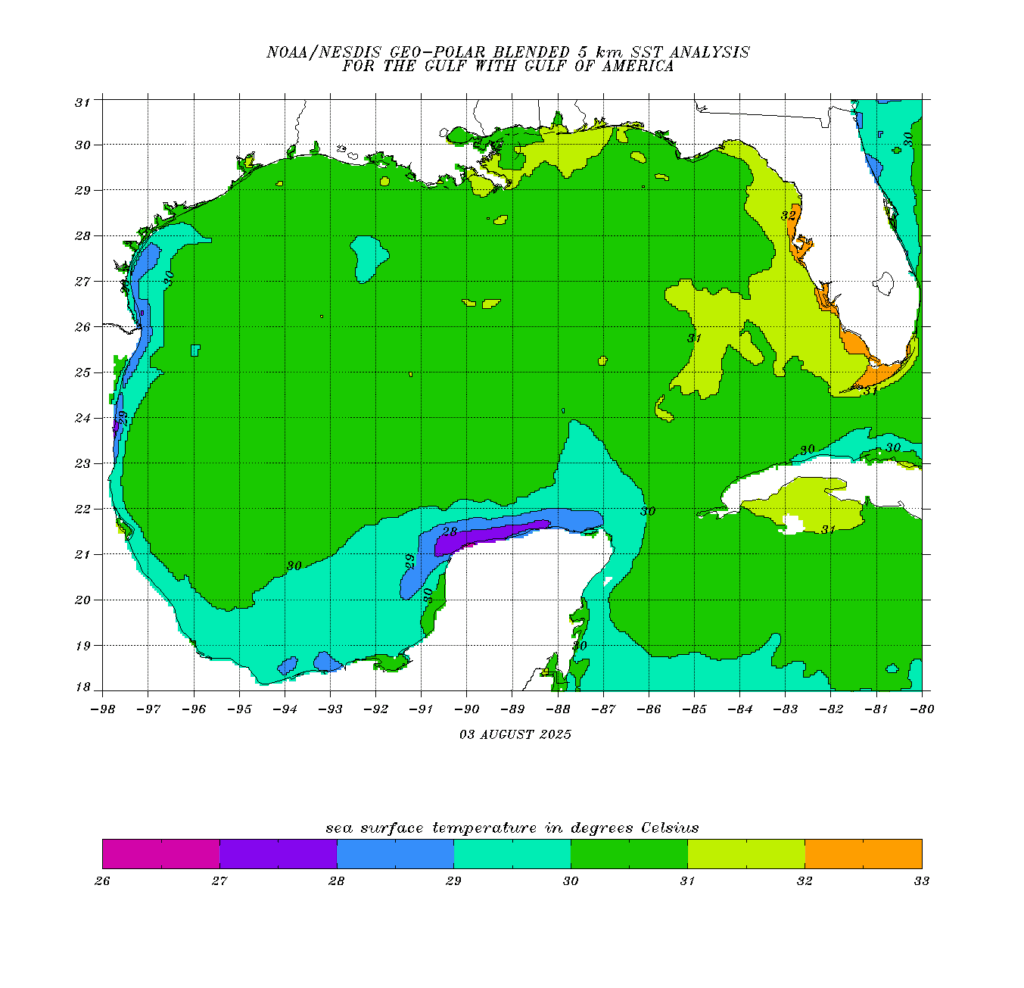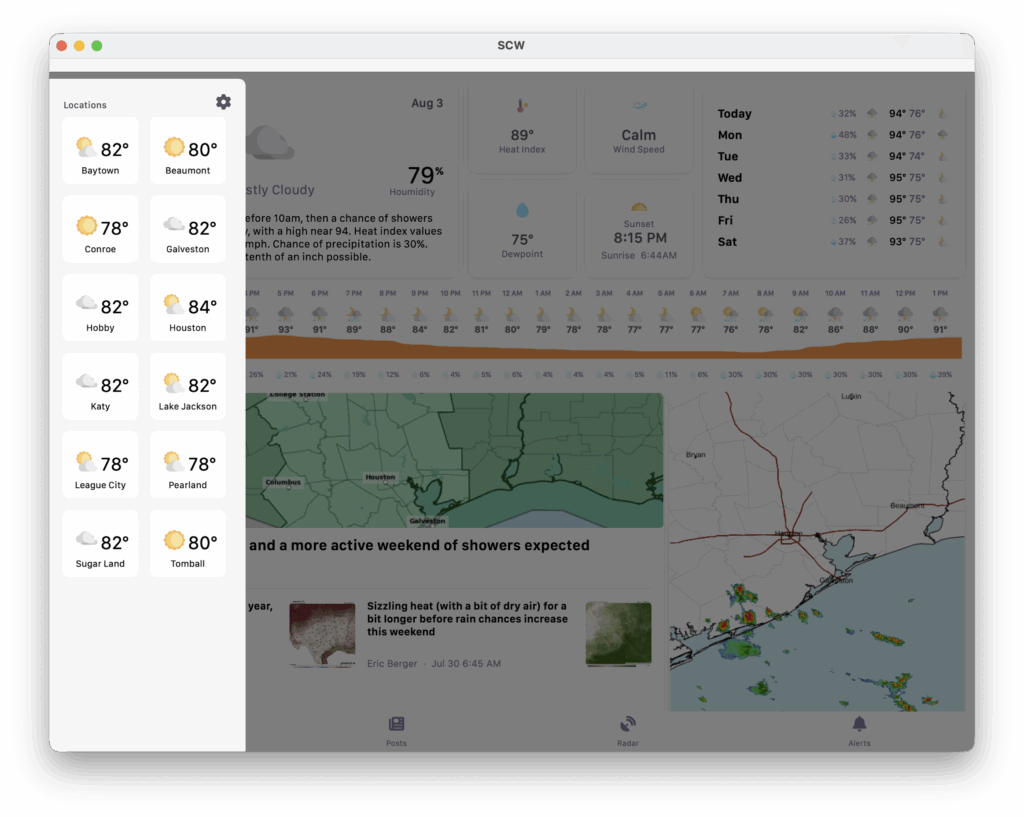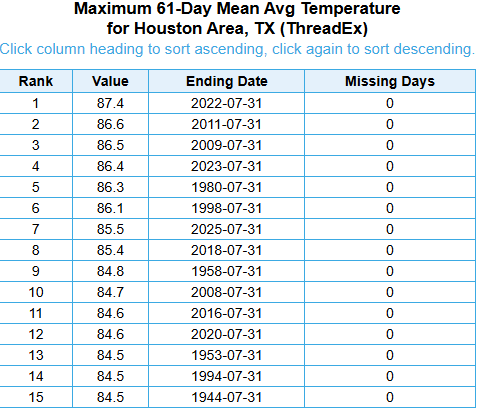Once again, you’ve asked and we’re answering. Here’s our latest Q&A. Got questions of your own? Hit the Contact link at the top of the blog, or leave a question here in the comments. We’ll consider it for next time.
Q: I’m not complaining at all, but it seems like this summer has been cooler than usual? I know we’ve had a lot of rain and maybe that’s kept things cooled off but is something bigger going on? Is there an overlying thing in the atmosphere that’s made June and July less than hellish?
A: Good question! We’ve actually already answered it because we felt the same thing! So, ok. Let’s look at this again with July now in the record books. Through the end of July it was officially the 7th hottest summer to date on record in Houston dating back to the late 1800s.
These temperatures are taken at Bush Airport, which about 20 percent of our audience thinks is complete blasphemy, another issue we addressed. And while Bush does have problems from a representation of Houston, when comparing to prior history at that specific location, it suffices. But, for those who would rather look at the data elsewhere as comparison, let’s do just that. At Hobby, it was the 15th hottest June & July on record back to 1931. In Galveston it was 4th hottest. College Station? 25th hottest. Corpus Christi was 9th. Beaumont was 44th! So, suffice to say there’s been variability across Southeast Texas. Was this really the 7th hottest start to summer “for Houston?” Officially, yes. In reality, probably not quite.
But it really depends on exactly where you are. And this gets to the reader’s mention of “a lot of rain.” Bush saw 9.46″ of rain in June and July, much less than last year of course, thanks especially to Hurricane Beryl. But if you took Beryl out of the equation it’s been a couple summers since we’ve had this routine amount of showers and storms. Hobby has had about 4 inches more rain this summer. Galveston has had far less, with about 4.5 inches officially. So it seems like the rankings of “hottest” are better correlated to rainfall than anything else. If you’ve seen more persistent daily storms in the Houston area, it’s been a good summer. If you haven’t, it hasn’t been horrible like 2022 and 2023, but it’s been a little hotter.
One thing I will note, that we’re basing this on average temperatures. When you look at nighttime lows, we’ve had more mornings at or above 78° this summer than in any prior summer in Houston. This persistence of warm nighttime lows is making a large impact on our overall average. This is for a number of reasons: A warming Gulf, urban sprawl and expanding heat island, and climate change. It’s just easier to have hot summers in Houston now than it used to be, even if the daytimes aren’t as bad as we’ve dealt with before.
– Matt
Q. Seems like we’ve had several low pressure systems near us (near shore) in the Gulf that IMO has really helped us with rainfall since June. Any chance these little low systems have pulled energy out of the Gulf that would keep something bigger from happening the next month or so?
A. The short answer is no, sorry. For two reasons.
First of all, it takes a stronger storm, preferably a hurricane, to really churn up lots of colder water from below toward the surface. This raising of colder water can produce a lingering effect on sea surface temperatures that reduces the energy available for subsequent storms to intensify. None of the weak systems we’ve seen to date have really been potent enough to have this effect.
Second, the effect is temporary, usually lasting on the order of two to four weeks. So even if the June tropical systems had a significant cooling impact on seas (which they really didn’t), it would be long gone.

Speaking of Gulf sea surface temperatures, they are plenty warm. The vast majority of the Gulf lies at 30 degrees Celsius or higher, rather far above the threshold (roughly 26.5 degrees C) needed to support tropical system intensification. Buckle up!
– Eric
Q: Matt, I know you have written about cuts to NOAA and NWS, and you’ve said the forecasting and warning around the Hill Country tragedy was not affected. But is there anything now you can point to and say, “That happened because of these cuts”?
A: I stand by my initial assessment. I don’t believe the cuts, as implemented thus far played much if any role in this disaster. As we’re learning from the state legislature’s special session, it appears there’s a fundamental problem with emergency response to significant weather in Kerr County in particular. While the NWS San Antonio office was without a warning coordination meteorologist at the time of the flood, the relationship building that occurs to help mitigate the toll from this sort of event occurs over a long period of time. Could it have helped here? Maybe a little? No one knows for sure. Would it have prevented it? No. I feel strongly that this was sort of a terrible situation, wrong place, wrong time, wrong leadership type of situation. Hopefully there are lessons learned from this.
I encourage you to read this by my friend and colleague, Alan Gerard, who really dug into what we know about the flood, the warnings, and the response.
The caution here, of course, is that the cuts that have been proposed to NOAA in the administration’s budget would be catastrophic to NWS and increase the risk profile across the board for events of this and lesser magnitudes. It made absolutely zero sense from a public safety standpoint. Thankfully, both legislative branches are playing the roles of grown-ups in the room and have come back and said those cuts aren’t happening. What this looks like in the end remains to be seen. But to this point, what is being said by Congress is actually net positive for NOAA and NWS and the country at large.
As far as other significant weather events and the current budget cuts, we have not noticed other cases where we can say with authority that the cuts have played a detrimental role in outcomes or forecasts. There was the instance of tornadoes earlier this year in Kentucky immediately after the Jackson, KY, office announced they’d stop staffing 24/7 due to the lack of staff. But the office was open and operational that night. The outcome was suboptimal, and the cuts may have played a role there — but like a lot of things, we can’t exactly prove it outright.
Same goes for the lack of weather balloons. On at least 2 or 3 occasions this year in forecasting for both the Houston area and for my day job in the Midwest, I have noticed a couple “surprise” outcomes that I strongly suspect are tied to the lack of upper air data provided by weather balloons that has been inconsistent from parts of the Rockies and Plains. But again, that’s speculation to some extent. We know for a fact that these are bad decisions, but proving what role they’ve played in any one event is difficult to do.
– Matt
Q. I was looking at my records and thought “hmm, haven’t done my annual contribution to SCW yet, let’s find a link on their website”. But no, couldn’t find one. Are donations only while you’re having your annual thing, or did I miss something?
A. You’re very kind to ask this. We hold an annual fundraiser over the course of three weeks in November. During this time period people can donate money to support the site and buy merchandise for the holiday season. Speaking of which, do you have any ideas for a t-shirt design this year? We want to do something fun for our 10th anniversary.
Why only November? We don’t have a year-round fundraiser because I don’t want the site to be seen as trying to capitalize during inclement weather events. In November, things are usually fairly calm, so there’s no pressure on people to support us.
– Eric
Q. Your app keeps crashing. What’s happening? I thought you fixed it!
A. Sigh. So did we!
When last we left our cute little weather app, we had released a new version that fixed the longstanding issue preventing notifications on Apple devices. As we wrote in June, it took a while to get this done because Hussain Abbasi, our developer, needed to switch to a new coding platform – something he wasn’t planning to do until next year but Microsoft dropped support for it.
The notification problem was indeed solved, but as is often the case when you’re making a change as major as this, other bugs were introduced. After the new version had been out for a while, we began to get reports of crashes when the app launched. Hussain found the issue, having to do with how the locations in the city-picker drawer get sorted. A updated release with a fix for that is imminent – hang in there! (In the interim, deleting and redownloading from the App Store seems to solve the problem.)

Meanwhile, he’s still in the process of getting the Android version working as it should via the new coding platform. Building Android apps can be more difficult because there are so many different hardware types and designs out there. In this case, you can blame folding Android devices for the delay – switching between tablet and phone layouts is creating, as he puts it, “inconsistencies.” (And there’s supposedly a folding iPhone coming next year. Yay?) Once we get an Android update out the door, it should also fix the issue of crashes on some Google Pixel phones.
It’s like playing whack-a-mole. Whack-a-bug!
Remember that you can send a bug report via the app. First make sure you’ve downloaded the latest version. Then tap the three-line icon next to the city name on the home page; tap the gear icon on the top right of the drawer that appears; tap the “Send Feedback” item. It sends a log with details on the crash to our developer, but it would help if you could provide as much detail as you can about what happened. (Details about your device are automatically sent.)
Does the app crash on launch so you can’t get to the Feedback button? Send as detailed a report as you can, including the device model and its operating system version, to [email protected].
And once again, just to be very clear: The spelling of Houmidity in the app is a feature, not a bug.
We appreciate your patience as Hussain works through these issues.
– Dwight
